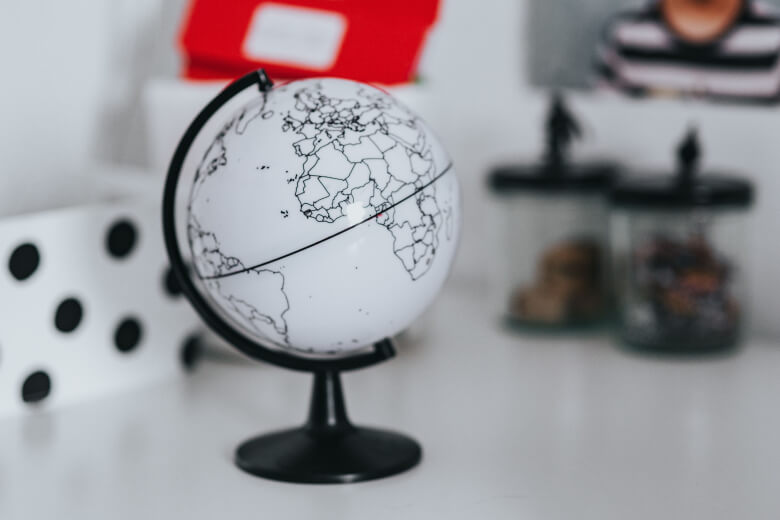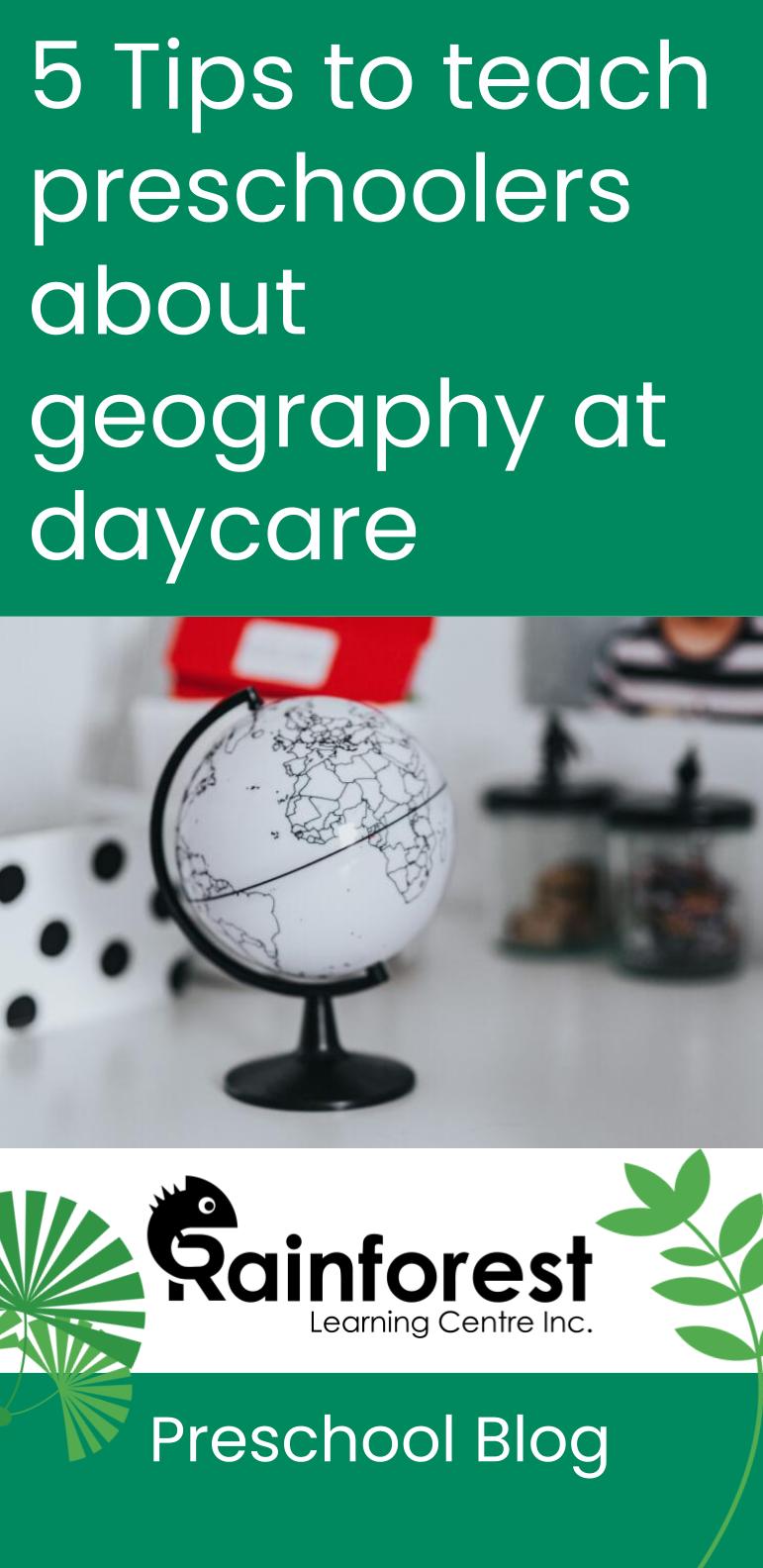
When children are toddlers, their ‘worlds’ are very small. They know about their house and their toys, and may understand the concept of ‘going’ somewhere nearby. For example, the park, or to grandma and grandpa’s house. They may understand that they have a nuclear family, and there are people they see sometimes, but who are not as close to them as caregivers and siblings. As they reach preschool age, you may notice they’ll recognize the ‘way’ to get somewhere. For example, in a car ride they’ll exclaim, “this is the bridge to go home!” They are starting to remember landmarks.
Helping children understand that the world is huge can benefit them in a variety of educational ways. For one, it can open up subjects to do with biology and chemistry, such as where animals and plants live, or how volcanoes erupt. It can also increase their vocabulary, by virtue of learning what the names of ‘things’ are, such as languages, cultures, buildings, landmarks, towns, flags, celebrations and, of course – the natural things found in various places.
However, teaching preschoolers about geography – whether at daycare, a half-day preschool, at home or in kindergarten – can also begin their journey on a wider array of lessons as they make their way through grade school. Geography is strongly connected to history, mathematics, archeology, weather, sociology and more.
We won’t all have children who make an appearance on the Ellen show because they’ve memorized every country and flag known to man. But, we can certainly see the benefits of making children aware of the planet earth that they live on, and its landmasses.
But, of course, we can’t bombard children at this age with a ‘mountain’ of information (pun intended!). They are little creatures, so we need to take ‘baby steps’ when teaching them about the big, round world we call home. In this article, we’ll offer some tips on how to teach preschoolers about geography.
1) Start with ‘big’ geographical categories and work your way down to ‘smaller’ segments
Don’t start by presenting your preschool classroom with a list of thousands of towns and cities. Some maps are extremely intricate. Yes, it’s cool to show children a complex network of roads on maps with tiny little city names. But these extensive maps may not be helpful at their age.
Instead, start by explaining that there are seven continents. Just seven! (Yes, we know that continental boundaries are not so cut-and-dry, but it’s ok to keep it simple for the kiddos, right?)
When you teach them about each continent, try to make associations with information the children already know about these places. This is a memorization trick, and it can be very helpful.
For example, when teaching about Australia, remind children about kangaroos, koalas and platypuses, which they may have already learned in an animal lesson. Explain that Australia is where these animals live. Lions and giraffes live in Africa, and so on.
You can also make associations with weather, foods, objects, landscapes or groups of people. For example, Inuit live in Northern continents, like North America and Russia. In Europe there are castles where princesses and knights used to live. In Asia they grow lots and lots of rice (or spices, teas, etc.). In South America there are lush rainforests. You get the idea…
Don’t get too confusing though: stick to concepts the children already know. Animals are a pretty easy one. Sticking to one categorization may also help by offering a single association that children can make between a country, and another set of ‘things’ they already understand as being ‘grouped.’
As you progress in your lessons, you can teach more and more about each content.
When they understand the 7 continents, you can talk about the 5 oceans. Then the countries. If you have enough time with the children, and they are speeding ahead, you can talk about provinces and cities. Or ranges of geological formation that span across countries. The point is, start big, and work your way down to the tinier concepts, where quantities are bound to increase.
See related on our blog:
2) Teach children about their local area, to make preschool geography lessons applicable and experiential
Another approach to teaching preschoolers about geography, is to show them maps, landscapes and features about the area where they currently reside. By taking this approach, geography can become a fun, experiential and applicable lesson. You can physically show children aspects of local geography. They can make connections to what they’ve learned when they are outside the classroom, or when learning informally.
See related on our blog:
- What is experiential education in early childhood, and why is it important?
- How to find and use teachable moments as an early childhood educator
Examples of experiential geography lessons can include:
Exploring your natural, nearby landscape with outdoor education
Perhaps you’ll start a classroom garden with children. Use this opportunity to teach them about the local climate, and how it affects the foods that can grow here, versus in other places. When you play outside, or go on a walk, visit the duck pond or walk in the forest, to teach about natural habitats. Outdoor education has many other benefits, which you can read about here.
Going on a field trip to the museum, aquarium, zoo and other educational places
While field trips can help children learn about international geography (such as by seeing exotic animals at the zoo or aquarium), preschool educators can use these types of field trips specifically to focus on local habitats, peoples and landscapes.
For example, in the Vancouver area, preschool classrooms can visit salmon hatcheries to see, first-hand, the way that salmon eggs are laid, and the amazing upward journey these creatures take to multiply.
They could also visit nearby farms and pumpkin patches, to learn about food grown in our climate.
They could visit historic places like First Nations museums and heritage museums, where they can be immersed in the lives of local people and their history in the area.
They can go gold panning to understand how minerals are found in our earth.
In the winter, they can go tobogganing in the snow after being taught about mountain slopes and seasons.
In the summer, they can go to the beach to learn about marine life.
See more of our field trip ideas, here.
3) Teach children about the geography of their parents’ home countries with classroom games and activities
Another way to make geography applicable to children, is to make it relatable. In our increasingly multicultural classrooms, children may speak different languages at home, bring different foods for lunch, or understand relationships and families differently.
A great way to create appreciation and cohesiveness (not to mention tolerance!) in children at a young age, is to introduce lessons about the homelands where classmates came from, or where their parents came from.
To that end, if you opt to do country or continent-focused geography lessons, pick the ones that represent where the children are from or originate. If you have several Koreans, Indians, Middle-Easterns or Mexicans in your classroom, highlight the shapes of their countries with individual cut-outs. Point out their locations on a map. Use this to teach North, East, West and South.
Then, tell stories from those countries. Learn their songs and games, or eat foods from those cultures (barring allergies, of course). You can do all of this in your preschool circle time.
Follow up with crafts and daily activities to reinforce what the children have learned in circle time. For example, bring in dramatic play costumes so children can reenact the cultural stories they’ve heard.
Or, set up play areas to mimic the environments in those countries. You can make palm trees (or post photos of them, or bring in potted plants) to depict a tropical location (here’s an example of a jungle diorama).
Bring pinatas to the classroom and have a fiesta.
Here’s an idea: if you do preschool yoga, teach children about where yoga came from! Make it a geography lesson!
4) Do geographic science experiments at preschool
With safety in mind, you can put on preschool science experiments that teach geography, too. The most obvious of these is, of course, a volcano!
While not exactly a science experiment, you can make a pudding or jell-o layered dish (in a clear container) with various yummy ingredients that form the earth’s crust. Add figurines like dinosaurs or lego people to show ‘us’ on top of the ‘earth’! By the way, this works with candy and cookie layers, or cookies and cake.
Bring in a helium balloon tank to teach children about air and weights. Bring in sticks and rocks from outside, and show that one of these floats in water, but the other doesn’t! Why is that? How does that scale? Can very big logs sink, even though they are heavier than small rocks?
Make s’mores and, while squishing the marshmallows and chocolate between the graham crackers, explain how mountains are made.
5) Bring in the maps and flags with paper, glue, stickers and play dough
When searching out preschool geography lesson activities, you’ll find a ton of ideas online. They usually have to do with paper maps, magazine cut outs, flashcards, dioramas and playdough. Of course, these are wonderful tactile learning materials to educate children about the map of the earth, with its continents, oceans, countries and landscapes.
Children can learn to place flag stickers on the appropriate countries, using a large classroom poster map.
Or, they can stick magnetic animals on the map, to see where their habitats are.
Flashcards with country shapes or flags can also be a fun game.
It’s also fun to make playdough ‘earth’ balls, or to squish playdough onto paper maps, to form 3D mountains and beaches.
We encourage you to scope out ideas that work for your classroom or home learning environment.
To conclude: teach preschool geography with simple concepts and fun activities
As we’ve seen above, preschool-aged children can be taught geography with the simplest of names and terms. Using associative memory techniques can help. This works by combining the concepts of what they already know, with the continents they are learning about.
Using circle time to teach geography with cultural stories or map lessons can be fantastic, especially in multicultural settings. But the preschool classroom can also learn about geography when going outdoors – either in their local neighbourhood or on field trips.
And of course, all the typical crafts and science experiments can go along with your interdisciplinary lesson planning on geography.
